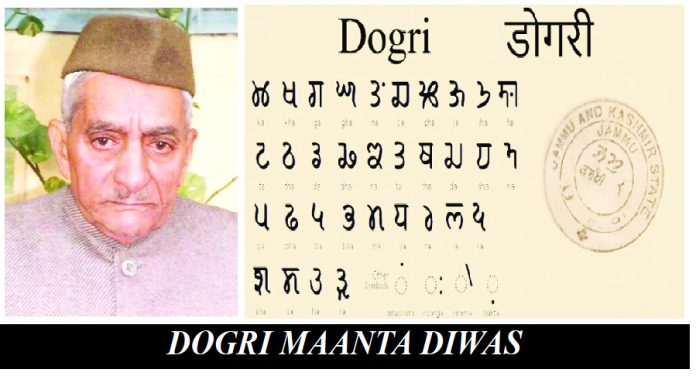Manju Sharma
As the ‘Dogri Maanta Divas’ (Dogri Manyata Diwas) is being celebrated on December 22, the contribution of Baldev Prasad Sharma towards inclusion of the Dogri language in the 8th Schedule of the Indian Constitution cannot be forgotten.
The historical documents that proved Dogri being an ancient language with its own script and grammar dished out by Mr. Sharma from the archives and other sources further pushed the case for inclusion of Dogri in the 8th Schedule.
The Dogri Sangharsh Samiti that launched an agitation and also met the central leaders, including the then PM Atal Behari Vajpayee, in support of their demand for the constitutional status for Dogri also carried certain documents researched by Mr. Sharma.
After his retirement as Director of All India Radio, Jammu and thereafter being appointed Director of Information & Public Relations (I&PR) in J&K, Mr. Sharma after 1975 devoted a lot of time in the Archives fishing important historical documents and scriptures related to Dogri literature.
After ten years when he relinquished charge of Director I&PR, he was nominated President of the Dogri Research Institute where he devoted full time towards research of ancient Dogri literature and grammar.
In a major research, he unearthed in the archives the Dogri grammar that was published about 150 years ago. Later, he was nominated a member of the Sahitya Akademy where he contributed towards promotion of Dogri literature.
It was on December 22, 2003, when Dogri was included in the Eighth Schedule of the Indian Constitution. The Ninety-second Amendment of the Constitution of India, officially known as The Constitution (Ninety-second Amendment) Act, 2003, amended the Eighth Schedule to the Constitution so as to include Bodo, Dogri, Maithili and Santali languages, thereby raising the total number of languages listed in the schedule to 22. The Eighth Schedule lists languages that the Government of India has the responsibility to develop.
Popularly known as the ‘walking encyclopaedia of Jammu and Kashmir’ and ‘Doyen of Dogra Culture’, he had the history of all important events, including the advancement of Dogri language during the Dogra rule, at his fingertips.
As a member of the Sahitya Academy for many years, he contributed much towards the development of the Dogri language.
He brought out documents proving that the Dogri alphabets were modified during the rule of Maharaja Ranbir Singh. Another momentous step in advancement of Dogri publication was casting of Dogri type which was used in the printing of ‘Vyaahar Gita’ (Dogri Grammar) in the Raghunath ji Press, Jammu, in 1884.
Mr. Sharma also contributed towards publication of the book “The Stamps of Jammu and Kashmir”, which was authored by Frits Staal, a professor at University of California, Berkeley, and published by the New York Collectors Club in 1983. The book carries a series of articles about the postal system under the Dogra rulers.
In the preface to “The Stamps of Jammu and Kashmir”, Frits Staal wrote: “The third scholar who has inspired and helped me is B.P.Sharma, President of The Dogri Research Institute of Jammu, and former Director of Information of the state of Jammu and Kashmir. When I visited Jammu for the first time, Shri Sharma walked me around tirelessly and provided a wealth of information far surpassing anything I had expected or even imagined. I could not have found a more authentic and authoritative source of knowledge on the Dogra renaissance of the later half of the 19th century in Jammu and Kashmir”. “Staal has in the preface mentioned that the book would not have been possible without the inspiration of Mr.Sharma who provided a “wealth of information far surpassing anything I had expected or even imagined”. “I could not have found a more authentic and authoritative source of knowledge on the Dogri Renaissance of the latter half of the 19th century in Jammu and Kashmir”.
According to an article written by Dr S P Shrivatsa, Mr. Sharma was the first scholar to have challenged the statement of the well-known linguist, Sir George Abraham Grierson, who in his “Linguist Survey of India” had said that neither the Dogri type nor any printed book in Dogri was in existence at a time he had visited Jammu. Mr. Sharma proved that about 20 Dogri books, some of them in Dogri type, were actually printed years before Grierson came to Jammu.
His tireless service in digging the history of Dogri language and culture brought him the distinction of being elected unanimously as President of Dogri Research Institute, Jammu, in 1978. He remained President of this prestigious Institute for over a decade.
It is worth mentioning that Mr. Sharma came out with valuable documents proving that Dogri language flourished during the regime of Maharaja Ranbir Singh who had made it mandatory for his officials to use Dogri in official communication.
What came as a curiosity for researchers is that Mr. Sharma also located in Srinagar’s Sri Pratap Singh Museum the Dogri type that was cast during the regime of Maharaja Ranbir Singh. A Dogri printing press, named as Vidya Vilas Press, also existed near the Raghunath Temple in Jammu.
In another landmark finding, Mr. Sharma is credited with extracting the rare Dogri translation of “Lilawati” that was printed in the Vidya Vilas Press in 1873. The book of knowledge was
originally written in Sanskrit by the celebrated Indian Astronomer and mathematician, Bhaskracharya. It was translated into Dogri by the first Dogri writer, Jyotshi Visheshwar, who at that time was principal of the Raghunath ji Pathshala.
Many scholars from abroad also appreciated Mr. Sharma for helping them with documents in their research on Dogra rule.
Trending Now
E-Paper


